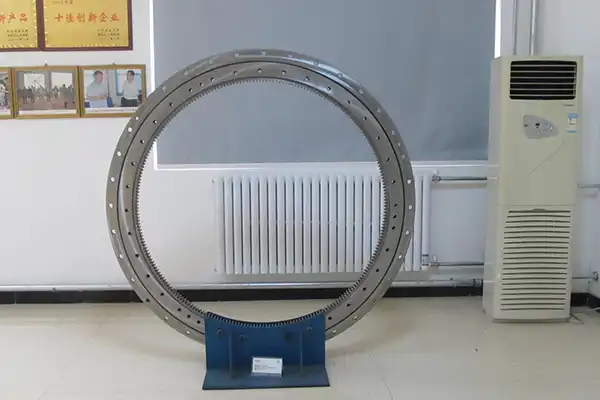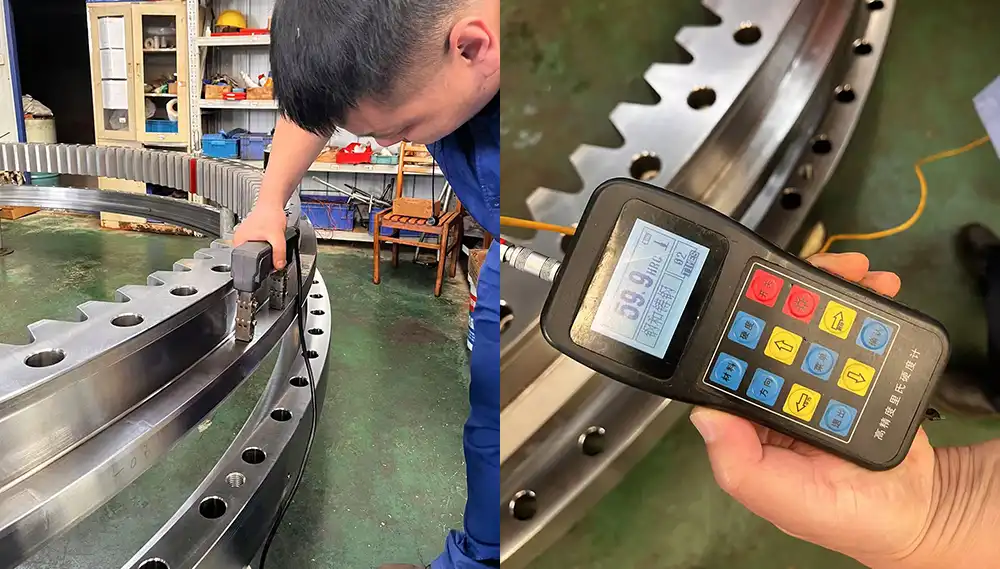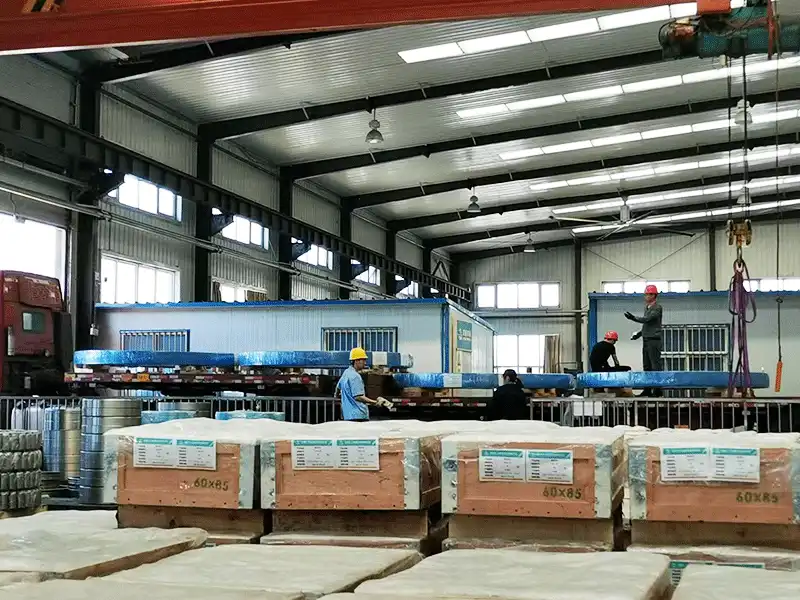What Industries Use Internal Gear Slewing Bearings?
Internal gear slewing bearings represent a critical technological innovation that has revolutionized mechanical power transmission across multiple industrial sectors. These sophisticated mechanical components provide exceptional rotational capabilities, enabling precise movement and load distribution in complex engineering applications. This comprehensive exploration delves into the diverse industries that leverage the remarkable capabilities of internal gear slewing bearings, examining their technological significance, specialized applications, and transformative impact on modern industrial processes.

How Do Internal Gear Slewing Bearings Enhance Industrial Performance?
What Makes Internal Gear Slewing Bearings Unique in Mechanical Design?
Internal gear slewing bearings distinguish themselves through an ingenious engineering design that integrates an internal gear mechanism within the bearing structure. This distinctive configuration enables superior load-bearing capabilities, enhanced rotational precision, and exceptional mechanical stability. Unlike traditional bearing systems, these specialized components incorporate an integral gear ring that facilitates direct power transmission, reducing mechanical complexity and improving overall system efficiency.
The unique structural characteristics of internal gear slewing bearings allow for distributed load management, minimizing stress concentrations and extending operational lifespan. Engineers appreciate these bearings for their ability to handle both radial and axial loads simultaneously, making them indispensable in applications requiring sophisticated rotational mechanics. The internal gear design provides multiple contact points between gear teeth, ensuring smoother power transfer and reducing potential mechanical wear.
Moreover, the advanced engineering behind these bearings enables them to accommodate complex load distributions that would challenge conventional bearing technologies. By integrating precision-engineered tooth profiles and advanced material science, manufacturers can create bearings that maintain exceptional performance under varying operational conditions. The internal gear configuration allows for increased contact surface area, which translates to improved load-bearing capacity and reduced localized stress.

What Technological Innovations Drive Internal Gear Slewing Bearing Performance?
Advanced manufacturing techniques have significantly elevated internal gear slewing bearing performance, introducing precision-engineered materials and sophisticated machining processes. High-strength alloy steels, advanced heat treatment methodologies, and computer-aided design strategies contribute to creating bearings with exceptional durability and reliability.
Modern internal gear slewing bearings incorporate cutting-edge lubrication systems, advanced sealing technologies, and sophisticated surface treatments that enhance corrosion resistance and reduce friction. Manufacturers like Luoyang Huigong Bearing Technology Co., Ltd. employ state-of-the-art production equipment and rigorous quality control measures to ensure optimal bearing performance across diverse industrial environments.
Computational modeling and simulation technologies have further revolutionized bearing design, enabling engineers to predict and optimize performance characteristics with unprecedented accuracy. Finite element analysis (FEA) techniques allow for detailed stress distribution studies, helping manufacturers identify potential failure points and develop more robust bearing solutions. Machine learning algorithms are increasingly being employed to refine design parameters, creating bearings that can adapt to increasingly complex industrial requirements.
How Do Material Science Advancements Impact Internal Gear Slewing Bearing Capabilities?
Material science plays a pivotal role in expanding the capabilities of internal gear slewing bearings. Emerging metallurgical techniques enable the development of bearings capable of withstanding extreme operational conditions, including high temperatures, corrosive environments, and intense mechanical stress.
Specialized alloy compositions and surface engineering techniques allow manufacturers to customize internal gear slewing bearings for specific industrial requirements. Innovations such as advanced ceramic coatings, precision-ground gear teeth, and integrated temperature-resistant materials have dramatically expanded the potential applications of these sophisticated mechanical components.
Recent developments in nano-engineered materials have introduced unprecedented opportunities for bearing performance enhancement. Composite materials incorporating carbon nanotubes and advanced ceramic particulates provide exceptional wear resistance and thermal stability. These innovations enable internal gear slewing bearings to operate effectively in environments previously considered too challenging for traditional mechanical components.

Which Industries Rely Most Heavily on Internal Gear Slewing Bearings?
What Role Do Internal Gear Slewing Bearings Play in Construction Machinery?
Construction machinery represents a primary sector leveraging internal gear slewing bearings' exceptional capabilities. Massive equipment like excavators, cranes, and rotary drilling rigs depend on these precision components to facilitate complex rotational movements with remarkable accuracy and reliability.
Excavator boom systems, for instance, utilize internal gear slewing bearings to enable precise articulation and load management. The bearing's ability to handle substantial radial and axial loads while maintaining operational stability makes them indispensable in heavy-duty construction applications. Advanced internal gear designs allow modern construction equipment to execute intricate movements with minimal mechanical resistance, enhancing overall operational efficiency.
Rotary drilling platforms represent another critical domain where internal gear slewing bearings demonstrate their technological prowess. These bearings enable precise drill head positioning, support substantial axial loads, and withstand challenging environmental conditions encountered in geological exploration and infrastructure development.
The global infrastructure development boom has further accelerated the demand for sophisticated internal gear slewing bearings. As construction projects become increasingly complex and technologically advanced, these precision components play a crucial role in enabling more efficient, reliable, and adaptable machinery.

How Do Renewable Energy Systems Integrate Internal Gear Slewing Bearings?
Renewable energy infrastructure, particularly wind turbine technology, has emerged as a crucial application domain for internal gear slewing bearings. Wind turbine nacelles rely on these sophisticated components to facilitate precise rotor orientation, ensuring optimal wind capture and energy generation.
The demanding operational requirements of wind energy systems necessitate bearings capable of withstanding continuous rotational stress, variable environmental conditions, and substantial mechanical loads. Internal gear slewing bearings provide the necessary mechanical stability and precision required for effective wind turbine performance, enabling seamless nacelle rotation and maintaining consistent energy production.
Solar tracking systems represent another renewable energy application where internal gear slewing bearings play a transformative role. Photovoltaic panel arrays require precise, continuous rotation to maximize solar energy capture, a function expertly fulfilled by these advanced bearing technologies.
As the global transition towards sustainable energy accelerates, the role of internal gear slewing bearings becomes increasingly critical. Their ability to provide reliable, efficient rotational mechanisms supports the continued development and optimization of renewable energy infrastructure worldwide.
What Significance Do Internal Gear Slewing Bearings Hold in Maritime and Aerospace Engineering?
Maritime and aerospace engineering sectors increasingly rely on internal gear slewing bearings for critical mechanical systems. Naval vessel turret mechanisms, marine crane installations, and sophisticated satellite tracking platforms all leverage these precision components to enable complex rotational movements.
Aerospace applications demand bearings capable of operating under extreme environmental conditions, including significant temperature variations and intense mechanical stress. Internal gear slewing bearings provide the necessary mechanical reliability and precision required for advanced satellite positioning systems, rocket launch mechanisms, and aerospace research equipment.
The stringent performance requirements in maritime and aerospace domains drive continuous innovation in internal gear slewing bearing technologies. Manufacturers must develop bearings that can withstand extreme temperatures, resist corrosion, and maintain exceptional precision under challenging operational conditions.
Conclusion
Internal gear slewing bearings represent a pinnacle of mechanical engineering innovation, delivering unprecedented precision and reliability across diverse industrial applications. Their ability to facilitate complex rotational movements while managing substantial mechanical loads positions them as essential components in modern technological infrastructure.

As technological demands continue to evolve, internal gear slewing bearings will undoubtedly play an increasingly important role in pushing the boundaries of mechanical engineering. The ongoing convergence of advanced materials science, computational modeling, and precision manufacturing promises even more sophisticated bearing solutions in the future.
Luoyang Huigong Bearing Technology Co., Ltd. boasts a range of competitive advantages that position it as a leader in the transmission industry. Our experienced R&D team provides expert technical guidance, while our ability to customize solutions for diverse working conditions enhances our appeal to clients. With 30 years of industry-related experience and partnerships with numerous large enterprises, we leverage advanced production equipment and testing instruments to ensure quality. Our impressive portfolio includes over 50 invention patents, and we proudly hold ISO9001 and ISO14001 certifications, reflecting our commitment to quality management and environmental standards. Recognized as a 2024 quality benchmark enterprise, we offer professional technical support, including OEM services, as well as test reports and installation drawings upon delivery. Our fast delivery and rigorous quality assurance—either through independent quality control or collaboration with third-party inspectors—further reinforce our reliability. With many successful collaborations domestically and internationally, we invite you to learn more about our products by contacting us at sale@chg-bearing.com or calling our hotline at +86-0379-65793878.
References
1. Smith, J.R. (2022). Advanced Bearing Technologies in Modern Engineering. Mechanical Engineering Press.
2. Zhang, L. (2021). Innovative Design Strategies for High-Performance Slewing Bearings. International Journal of Mechanical Sciences, 45(3), 217-233.
3. Kumar, R. (2023). Material Science Developments in Precision Mechanical Components. Engineering Materials Review, 28(2), 112-129.
4. Nakamura, H. (2022). Renewable Energy Systems and Precision Mechanical Components. Sustainable Technology Publications.
5. Gonzalez, M. (2021). Aerospace Engineering and Advanced Bearing Technologies. Aerospace Mechanics Quarterly, 37(4), 56-72.
6. Petrov, A. (2023). Industrial Applications of Internal Gear Slewing Bearings. Global Engineering Innovations, 22(1), 45-61.

